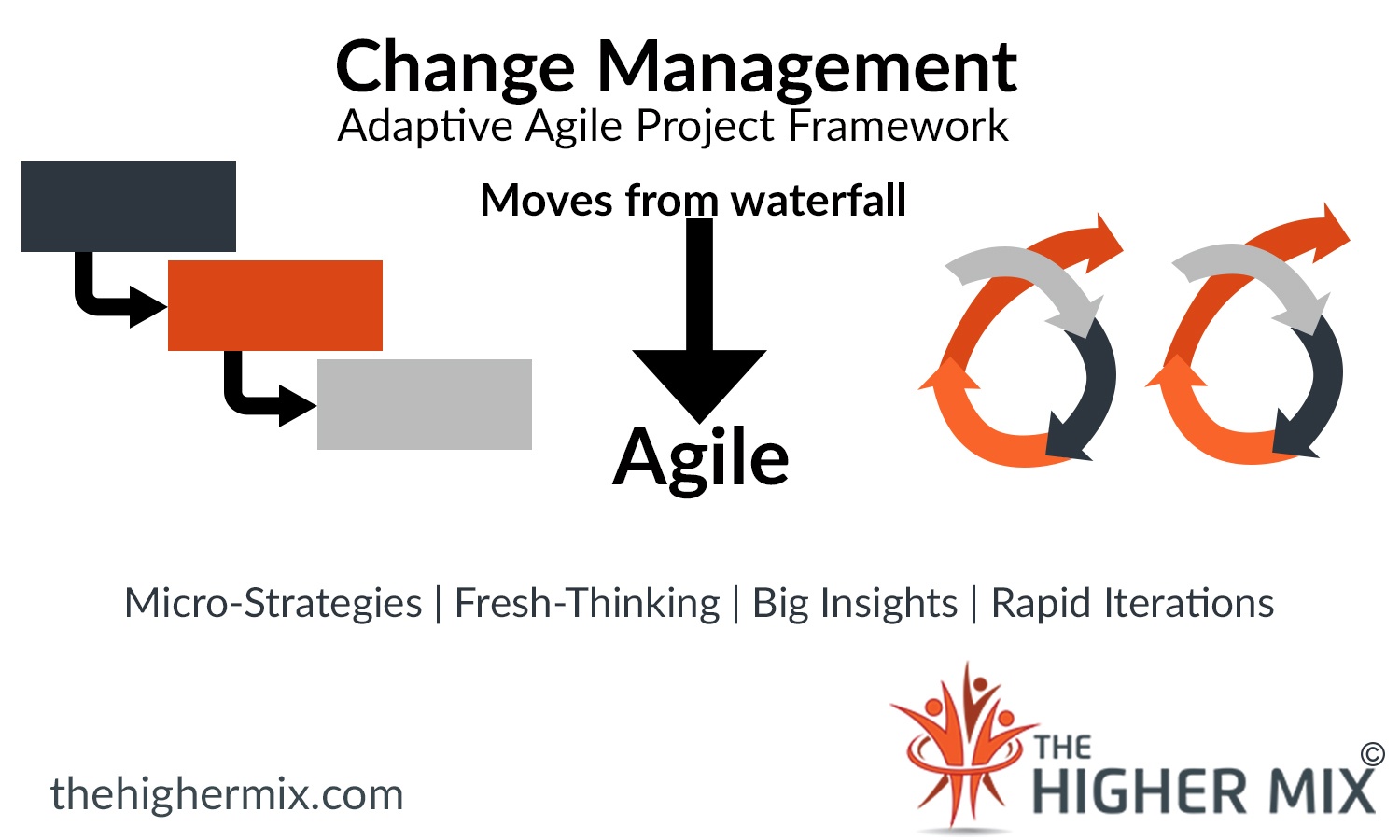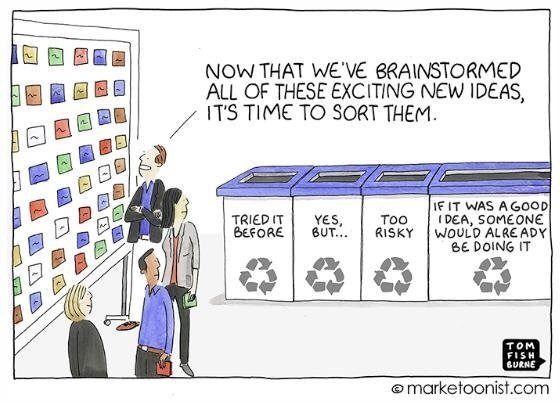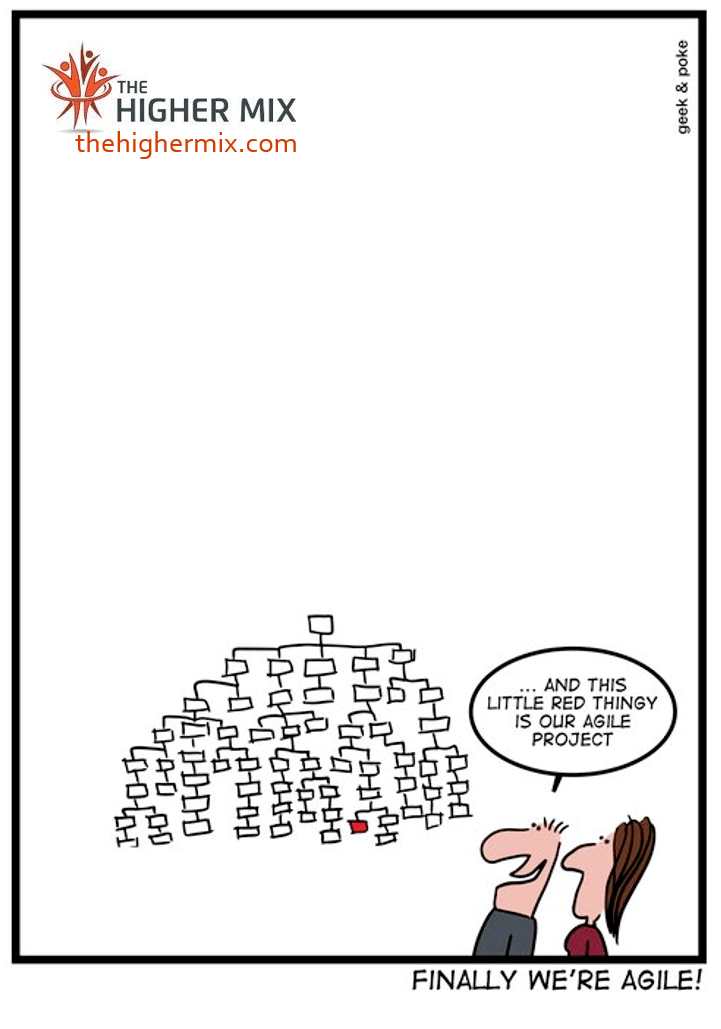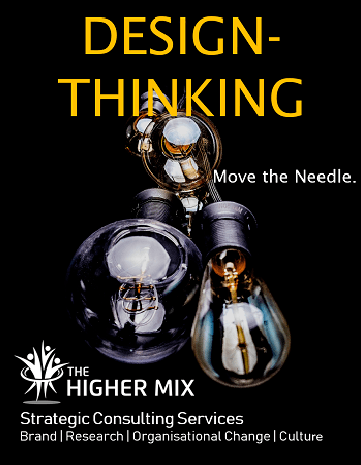Times have changed. So too customer requirements, tastes, lifestyles along with how we communicate. As Innovators, we constantly seek out the next big idea, technology, or service promising to make both our ideas and people indispensable.
Staying current means organizations must move with change. While no one person can predict the future, Design Thinking goes a long way towards providing us with the map.
[thrive_headline_focus title=”What is Design Thinking?” orientation=”left”]
Design Thinking (DT) is repeatable, proven problem-solving -a value-creating protocol for any profession, organisation or business, they will use to achieve big results.
Designer sensibility and methods applied to systems, procedures, and customer/user experience. With DT, a cross-functional blend of inter-disciplinary teams solving complex problems. Value-adding solution-focused methods, pooling and profiting from different perspectives, ramping up visibility and investigating what’s required for real team or customer-centricity. All to arrive at, define, isolate and fix the major issues in businesses.
An adaptive framework, extremely useful in tackling complex problems – ill-defined, wicked or unknown. New and improved solutions to your problems at hand. By combining creative/critical thinking, allows ideas and information to be better organised – for sound decisions made on projects, knowledge, and diversity-of-thought, all this over some of the shortest timelines.
Design Thinking aims at finding solutions (for the many!) …not only focusing on a problem. Draws on research, logic, imagination, intuition, and systemic reasoning to explore possibilities of what could be (desired outcomes to benefit end-users, internal teams, customers, other stakeholders.)
Fostering far deeper, stronger collaboration across teams. Very much art-meets-science approach to empower your people’s thinking and ideas and unleash their inner curiosities (…even goes for most hardened, traditional thinkers too.)
[thrive_headline_focus title=”Continuously Redesign Your Business” orientation=”left”]
Well past time for fresh thinking, for organizations to adopt different information,entirely new structures Future of Work Innovation systems. Because now it’s round two – yet another shift in the way we work post-Covid-19. Again needing to restructure our businesses, only this time we have machines also transforming our brands, economies, industries and societies.
Design-thinking companies stand head & shoulders above the rest, for their willingness to engage in continuous redesign of their businesses.
McKinsey outlines top-level trends dramatically changing how workplaces, organisations and teams are working. [one_fourth_first]Evolve quickly to Environments: Demand patterns of stakeholders are altering rapidly, the pressing needs of teams, customers, partners, policymakers and regulators, along with growth demand, makes acquisitions /restructuring necessary. Take action if you need guidance to accommodate altering priorities.[/one_fourth_first][one_fourth]Accelerate Digitization, Democratisation of information: Companies engaging heavily in multi-directional communications, working in complex collaboration scenarios (increasing their volume, distribution, transparency required between colleagues, internal teams, customers and partners.)[/one_fourth][one_fourth]Introduce disruptive technologies: Commoditisation of established businesses; where the company is being eroded, or challenged due to digitization, advancement, or innovative use of new models – and of course, automation; Machine learning, IoT, Robotics etc skew workplaces and our world.[/one_fourth][one_fourth_last]Brand new war for talent: Design mindsets, creative empowerment, learning-based tasks, and revisiting of the Employer profile all act as drawcard to your brand. Distinctive value propositions EVP and CVP are required to acquire, engage, retain the best tech talent. [/one_fourth_last]
[thrive_headline_focus title=”Design Thinking Businesses Win” orientation=”left”]
Virtually impossible for organizations to be truly successful unless their company is disrupting others and markets.
Scale of impact has led to traditional companies to be asking “how can we/do we adapt fast; move as quickly as a nimble start-up?” Get beyond solution development to redesigning themselves, and implementing enterprise-wide operating models based on similar principles.
Everyone understands all those benefits to innovation, being tasked with the job of actually doing it, is a whole different thing entirely. Every single company has to be morphing; improving systems, and making human elements the priority.
Design Thinking matches needs of people (supported by technology) underpinned by viable business strategy and turns these into real customer value and market opportunities. Less concerned with the necessary. Focused disciplines on the contingent (read: not how things are, but how they could be!?)

Still a hell of an endeavour to create necessary advances in both efficiency and innovation (a most potent combination for competitive edge.)
‘People-centered’ culture, and your team networks operate in rapid learning cycles, seeking faster decisions, different working structures enabled by technology – they are the hallmarks of Design Thinker organizations. But the common thread here is purpose.
Purpose and direction underpin speedy co-creation; keep your people heading in the right direction to derive more value for a wide range of stakeholders – as the team produces new strategy for brands or products, or revitalized marketing?
With design thinkers in hubs and collaborating – businesses are investing heavily, ploughing valuable resources into ideation, co-creation, and experimentation that hopefully (!) will arrive at innovations people will love. However the smart exec will ask themselves – just how successful are we really in making that leap from isolated agile projects to full-scale transformation of the business? Is this working? Where’s the impact? Social proof?
For innovation to succeed – first innovation leaders, key managers and collaborators must:
- Recognize there is no quick fix – true innovation is a process;
- Must stop executing the innovation process backward: refrain from cobbling together incompatible innovation tools and methods;
- Understand that a budget, time and outside expertise is very often required to support their teams and correctly execute DT processes;
- Warm up to change – use key data and research you have – warning: that should be altering your operating model and methods too (or the organization is wheel-spinning.)
Reshaping quickly involves overcoming all difficulties associated with achieving “nimbleness” – in itself made more complex by human elements. People’s view of the world (workplace) will tend to endure; until such time as they can’t explain new evidence or make sense of situations….only then do we start to see paradigm shift.
Nowadays, there are untold numbers of new creative approaches to problem-solving. But how do you know you have the right one? Companies are all over rushing to alter learning inside the business – to think like designers, and apply next-gen change principles into workplaces – but at what cost to the org and the teams. Esp. if it is heading down the wrong path.
All that starts (and ends) with People.
Design Thinking is personal in nature. Relates to people’s needs and challenges – which makes it a valuable methodology for leveraging empathy from people. Sense-making and bringing forward the right mindsets to inspire the development of emotionally/ functionally-valuable human experiences and workforces.
Every waking minute, companies are consumed with task overflow. Fighting imperfect organisational structures; what falls out of this is most often, inaction by leaders. Busy managers don’t cope well with exploding innovation agendas and environments. Hear this “never enough time” to clear our thoughts or even obsess a little bit over the intricacies of Cx (customer experience).
But without it, organizations get lost…. Become ripe for chaos, complexity, inefficiencies, and no surprise usually suffer declining market share, as a result. As organisational health experts, we don’t notice many new pathways being developed either. Example being performance evaluation model…. is (was) broken; certainly redundant because it continued to yield all the WRONG answers and not adequately cope with this new breed of talent on our decks- they operate very differently.
[thrive_headline_focus title=”Adapt to New Ways of Working” orientation=”left”]
So we know, Design Thinking is a method for meeting people’s needs – and giving them a voice and license to produce a solution, technologically feasible and strategically viable.
Human-centered design aims to drive customer/team focus deeper inside organizations. Less about the detailed elaboration of ideas – more about extensive experimentation. Big draw-card ideas improve people’s quality of life (workplaces EVP Alignment, Internalisation, product use at home and across the planet.)
Be a bit cautionary here. End-users might well provide insights that are tangible (driven by data and market research) but what companies should seek here is a much more thorough understanding of their people and associated brand health problems. Understand those key drivers to organisational change and effectiveness – this is central to any business buildof new compelling experiences – not just for their customers, equally for own internal teams too.
[thrive_headline_focus title=”Customer-Led Innovation” orientation=”left”]
DT has already changed the entire way we think about, and do work.
With excellent frameworks (parameters, values and goals) for customer-led innovation into organizations but just like anything in life, it all comes down to the execution.
Just how well your organization employing methods and people’s skills, used on projects (applied to various design activities)? Anything but concrete or inflexible in its approach, Design Thinking is a thrilling ride, esp. at the beginning. No-one ever really knows exactly where it will take them. What we can be sure of is this. The destination promises to be far more innovative and relevant.
Watch Lena Ross’s 3-min video on Agile Change.
[thrive_headline_focus title=”Co-Created Change: Problem-Seek/Solve with your own People” orientation=”left”]
Getting a grip on human needs and interactions. Re-framing existing problems in human-centric ways for a plethora of ideas brainstormed and quickly followed up with hands-on prototyping, testing, and adoption. Under all this, Design Thinking mandate which respects the value of ‘thinking’.
However, design thinkers must set aside their own assumptions about a product, customer or world, in order to gain necessary insights into user needs. Then opportunities will open up to your team. Chance for them to assimilate directly into the processes that govern their own company. Using their inputs to help overcome organisational inertia or resistance to positive change.

Occasionally internal teams find themselves so focused on generating ideas (very often somewhat self-serving to their own interests or situations.) Where the customer need becomes almost secondary….sometimes even absent.
Where decisions made on important situations/people in functional isolation, which unknowingly results in fragmented decision-making – and it is the customers who feel that pain… long before anyone internally realizes they do.
[thrive_headline_focus title=”Shaping Culture is where its At.. And Leaders too” orientation=”left”]
We aren’t advocating organizations should ditch their planning or existing strategic priorities. Rolling out any form of business strategy requires rigour. Good design work internally provides that platform for stronger focus, informs criteria for evaluation of competing ideas, and that speedy ability to frame/re-frame problems on the ground faster.
BOOK A SHORT INTRO SESSION WITH US
[thrive_headline_focus title=“Move the Needle – Give Teams Time To Think and Produce “ orientation=”left”]
Moving through any transformation requires agreement from leaders and their alignment to both the aspirations (…and value) of the exercise. Leaders must inspire, support and empower teams – many had better get good at this, and fast.
Willingness and openness to share knowledge, up for serious collaboration between depts, dedicating proper amounts of time to thinking through the style of work being done inside it, and for the customers outside of the business too.
So, what’s being done to guarantee creativity and innovation are flourishing?
Is your business simplifying? Cutting through all that red tape? Solving the right problems? How does it measure merit? Redirect effort in the best direction for viable solutions? Alter learning in the business?
This further extends to what organisations are doing, in terms of investing for (attract, retain) and in (development and engagement) the right talent?
Are we giving teams time for testing, encouraging their fast failure, providing sound business systems, and advice in support? What of intrinsic skills needed to be a much more successful organization? Do we even know what these skills are? Just where will you find these talented people to fuel company growth? Because skills crunch for tech people is here….
If we’re all truly honest about all those, we understand the primary means, our business strategy has to change. To reposition into different directions/markets, and have our people, company narratives, and marketing support that.
[thrive_headline_focus title=”Design Thinking Comes With Its Own Set Of Unique Challenges ” orientation=”left”]
Design Thinking isn’t always easy to adopt – esp. in relation to organisational change (regardless of the change framework, will always be struggles to shoulder) ….this we know, from our many years of dealing in transformational change. Forget trying to design “end state” in granular detail. Given depth and breadth of the transformation, necessary to be succint and aligned high level (as to the aspirations, value, and plausible plans to achieve.)
This will work for all types of organizations – big and small. The largest challenge tends to arise during implementation and more so, for established companies – who are themselves typically wound up with stringent processes and systems. Nonetheless, benefits certainly outweigh the process of cutting through all that red tape. And that exactly is what Design Thinking does….simplify.
Important for any organization’s ability to adapt, innovate and learn rapidly. Takes their problem/s, chunks them down and enables your teams to drill down on core issue/s quickly, then clearly piece together critical aspects for far stronger solution.
Whatever that looks like – still adopt the same underlying principles – iterative development, deep cross-functional team collaboration, frequent releases, laser focus on the customer and our own teams.
Value Drivers used through Transformation

Before we close this Blog, limiting agile to pilots, i.e. a smaller part of the organization may well be a “safe” option and initially might see a pilot or two successful but this will only have a restricted impact (maybe to few teams or groups of technologists). Also possibly prevent your exec teams from fully grasping far-reaching impact and strategic value to a far broader adaptive transformation, as well.
Very last thing your company wants/needs is a series of pilots happening – before being eventually killed off because they didn’t arrive with outcomes or because now there’s some other need to reallocate that funding for new initiatives arising.
Also, absence of alignment – where companies gear up to adopt DT (customer focus, experimentation, empowered teams) only to end up creating a cacophony of stresses for leaders or all these totally disparate approaches happening – so as humans, you find they will just dig in, push-back and try to maintain a status quo.
So the Drivers include the Guided Design of the Operating Model to ensuring value is delivered. Metrics, designed to monitor value-capture during execution. Fail in these two areas and you constrain the impact that transformation will have.
To overcome limits to the impact of your transformation; avoid teams across different parts of the organisation applying agile to varying degrees and flavours – this leads to significant increases in overheads, people struggling to manage this through states, and across teams. Where they spend very little time really considering (tracking) the TRUE value their effort is/has actually delivered.
Beyond Proof of Concept… to Proof of Value
Enterprise-wide transformation has become the number one priority for any organisation. To drive this real impact, execs have to take more interest, understand, adopt, and implement key changes to business practices in order to support a more adaptive, technology-driven organisation.
Any bottom-up change, in ways of working at team level, won’t only change the way executive levels operate – will have a profound, often disproportionate impact on people too.
When we coach organizations on the recipes for success – the first question we always ask is ‘How much are we willing to give up?’ Ambitious transformation starts with breaking leaders out of working inside the paradigm of ‘old’ culture (where there’s still this underlying hesitation to empower teams, where they feel they need to be across all this detail on inner workings…. like fearfully demanding project-management status reports daily, weekly.
In other words, leaders empowered, minimizing red tape and bureaucracy and creating truly cross-functional, empowered high-calibre teams, with the grit and experience to drive your innovation agenda.
Chat with Jo Woodfield HERE or email jo@thehighermix.com
Design Thinking Businesses Win
Virtually impossible for organizations to be truly successful unless their company is disrupting others and markets.
Scale of impact has led to traditional companies to be asking “how can we/do we adapt fast; move as quickly as a nimble start-up?” Get beyond solution development to redesigning themselves, and implementing enterprise-wide operating models based on similar principles.
Everyone understands all those benefits to innovation, being tasked with the job of actually doing it, is a whole different thing entirely. Every single company has to be morphing; improving systems, and making human elements the priority.
Design Thinking matches needs of people (supported by technology) underpinned by viable business strategy and turns these into real customer value and market opportunities. Less concerned with the necessary. Focused disciplines on the contingent (read: not how things are, but how they could be!?)

Still a hell of an endeavour to create necessary advances in both efficiency and innovation (a most potent combination for competitive edge.)
‘People-centered’ culture, and your team networks operate in rapid learning cycles, seeking faster decisions, different working structures enabled by technology – they are the hallmarks of Design Thinker organizations. But the common thread here is purpose.
Purpose and direction underpin speedy co-creation; keep your people heading in the right direction to derive more value for a wide range of stakeholders – as the team produces new strategy for brands or products, or revitalized marketing?
With design thinkers in hubs and collaborating – businesses are investing heavily, ploughing valuable resources into ideation, co-creation, and experimentation that hopefully (!) will arrive at innovations people will love. However the smart exec will ask themselves – just how successful are we really in making that leap from isolated agile projects to full-scale transformation of the business? Is this working? Where’s the impact? Social proof?
For innovation to succeed – first innovation leaders, key managers and collaborators must:
- Recognize there is no quick fix – true innovation is a process;
- Must stop executing the innovation process backward: refrain from cobbling together incompatible innovation tools and methods;
- Understand that a budget, time and outside expertise is very often required to support their teams and correctly execute DT processes;
- Warm up to change – use key data and research you have – warning: that should be altering your operating model and methods too (or the organization is wheel-spinning.)
Reshaping quickly involves overcoming all difficulties associated with achieving “nimbleness” – in itself made more complex by human elements. People’s view of the world (workplace) will tend to endure; until such time as they can’t explain new evidence or make sense of situations….only then do we start to see paradigm shift.
Nowadays, there are untold numbers of new creative approaches to problem-solving. But how do you know you have the right one? Companies are all over rushing to alter learning inside the business – to think like designers, and apply next-gen change principles into workplaces – but at what cost to the org and the teams. Esp. if it is heading down the wrong path.
All that starts (and ends) with People.
Design Thinking is personal in nature. Relates to people’s needs and challenges – which makes it a valuable methodology for leveraging empathy from people. Sense-making and bringing forward the right mindsets to inspire the development of emotionally/ functionally-valuable human experiences and workforces.
Every waking minute, companies are consumed with task overflow. Fighting imperfect organisational structures; what falls out of this is most often, inaction by leaders. Busy managers don’t cope well with exploding innovation agendas and environments. Hear this “never enough time” to clear our thoughts or even obsess a little bit over the intricacies of Cx (customer experience).
But without it, organizations get lost…. Become ripe for chaos, complexity, inefficiencies, and no surprise usually suffer declining market share, as a result. As organisational health experts, we don’t notice many new pathways being developed either. Example being performance evaluation model…. is (was) broken; certainly redundant because it continued to yield all the WRONG answers and not adequately cope with this new breed of talent on our decks- they operate very differently.
Adapt to New Ways of Working
Adapt to New Ways of Working
So we know, Design Thinking is a method for meeting people’s needs – and giving them a voice and license to produce a solution, technologically feasible and strategically viable.
Human-centered design aims to drive customer/team focus deeper inside organizations. Less about the detailed elaboration of ideas – more about extensive experimentation. Big draw-card ideas improve people’s quality of life (workplaces EVP Alignment, Internalisation, product use at home and across the planet.)
Be a bit cautionary here. End-users might well provide insights that are tangible (driven by data and market research) but what companies should seek here is a much more thorough understanding of their people and associated brand health problems. Understand those key drivers to organisational change and effectiveness – this is central to any business buildof new compelling experiences – not just for their customers, equally for own internal teams too.
Customer-Led Innovation
Customer-Led Innovation
DT has already changed the entire way we think about, and do work.
With excellent frameworks (parameters, values and goals) for customer-led innovation into organizations but just like anything in life, it all comes down to the execution.
Just how well your organization employing methods and people’s skills, used on projects (applied to various design activities)? Anything but concrete or inflexible in its approach, Design Thinking is a thrilling ride, esp. at the beginning. No-one ever really knows exactly where it will take them. What we can be sure of is this. The destination promises to be far more innovative and relevant.
Watch Lena Ross’s 3-min video on Agile Change.
Co-Created Change: Problem-Seek/Solve with your own People
Co-Created Change: Problem-Seek/Solve with your own People
Getting a grip on human needs and interactions. Re-framing existing problems in human-centric ways for a plethora of ideas brainstormed and quickly followed up with hands-on prototyping, testing, and adoption. Under all this, Design Thinking mandate which respects the value of ‘thinking’.
However, design thinkers must set aside their own assumptions about a product, customer or world, in order to gain necessary insights into user needs. Then opportunities will open up to your team. Chance for them to assimilate directly into the processes that govern their own company. Using their inputs to help overcome organisational inertia or resistance to positive change.

Occasionally internal teams find themselves so focused on generating ideas (very often somewhat self-serving to their own interests or situations.) Where the customer need becomes almost secondary….sometimes even absent.
Where decisions made on important situations/people in functional isolation, which unknowingly results in fragmented decision-making – and it is the customers who feel that pain… long before anyone internally realizes they do.
Shaping Culture is where its At.. And Leaders too
Shaping Culture is where its At.. And Leaders too
We aren’t advocating organizations should ditch their planning or existing strategic priorities. Rolling out any form of business strategy requires rigour. Good design work internally provides that platform for stronger focus, informs criteria for evaluation of competing ideas, and that speedy ability to frame/re-frame problems on the ground faster.
BOOK A SHORT INTRO SESSION WITH US
Moving through any transformation requires agreement from leaders and their alignment to both the aspirations (…and value) of the exercise. Leaders must inspire, support and empower teams – many had better get good at this, and fast.
Willingness and openness to share knowledge, up for serious collaboration between depts, dedicating proper amounts of time to thinking through the style of work being done inside it, and for the customers outside of the business too.
So, what’s being done to guarantee creativity and innovation are flourishing?
Is your business simplifying? Cutting through all that red tape? Solving the right problems? How does it measure merit? Redirect effort in the best direction for viable solutions? Alter learning in the business?
This further extends to what organisations are doing, in terms of investing for (attract, retain) and in (development and engagement) the right talent?
Are we giving teams time for testing, encouraging their fast failure, providing sound business systems, and advice in support? What of intrinsic skills needed to be a much more successful organization? Do we even know what these skills are? Just where will you find these talented people to fuel company growth? Because skills crunch for tech people is here….
If we’re all truly honest about all those, we understand the primary means, our business strategy has to change. To reposition into different directions/markets, and have our people, company narratives, and marketing support that.
Design Thinking Comes With Its Own Set Of Unique Challenges
Design Thinking Comes With Its Own Set Of Unique Challenges
Design Thinking isn’t always easy to adopt – esp. in relation to organisational change (regardless of the change framework, will always be struggles to shoulder) ….this we know, from our many years of dealing in transformational change. Forget trying to design “end state” in granular detail. Given depth and breadth of the transformation, necessary to be succint and aligned high level (as to the aspirations, value, and plausible plans to achieve.)
This will work for all types of organizations – big and small. The largest challenge tends to arise during implementation and more so, for established companies – who are themselves typically wound up with stringent processes and systems. Nonetheless, benefits certainly outweigh the process of cutting through all that red tape. And that exactly is what Design Thinking does….simplify.
Important for any organization’s ability to adapt, innovate and learn rapidly. Takes their problem/s, chunks them down and enables your teams to drill down on core issue/s quickly, then clearly piece together critical aspects for far stronger solution.
Whatever that looks like – still adopt the same underlying principles – iterative development, deep cross-functional team collaboration, frequent releases, laser focus on the customer and our own teams.
Value Drivers used through Transformation

Before we close this Blog, limiting agile to pilots, i.e. a smaller part of the organization may well be a “safe” option and initially might see a pilot or two successful but this will only have a restricted impact (maybe to few teams or groups of technologists). Also possibly prevent your exec teams from fully grasping far-reaching impact and strategic value to a far broader adaptive transformation, as well.
Very last thing your company wants/needs is a series of pilots happening – before being eventually killed off because they didn’t arrive with outcomes or because now there’s some other need to reallocate that funding for new initiatives arising.
Also, absence of alignment – where companies gear up to adopt DT (customer focus, experimentation, empowered teams) only to end up creating a cacophony of stresses for leaders or all these totally disparate approaches happening – so as humans, you find they will just dig in, push-back and try to maintain a status quo.
So the Drivers include the Guided Design of the Operating Model to ensuring value is delivered. Metrics, designed to monitor value-capture during execution. Fail in these two areas and you constrain the impact that transformation will have.
To overcome limits to the impact of your transformation; avoid teams across different parts of the organisation applying agile to varying degrees and flavours – this leads to significant increases in overheads, people struggling to manage this through states, and across teams. Where they spend very little time really considering (tracking) the TRUE value their effort is/has actually delivered.
Beyond Proof of Concept… to Proof of Value
Enterprise-wide transformation has become the number one priority for any organisation. To drive this real impact, execs have to take more interest, understand, adopt, and implement key changes to business practices in order to support a more adaptive, technology-driven organisation.
Any bottom-up change, in ways of working at team level, won’t only change the way executive levels operate – will have a profound, often disproportionate impact on people too.
When we coach organizations on the recipes for success – the first question we always ask is ‘How much are we willing to give up?’ Ambitious transformation starts with breaking leaders out of working inside the paradigm of ‘old’ culture (where there’s still this underlying hesitation to empower teams, where they feel they need to be across all this detail on inner workings…. like fearfully demanding project-management status reports daily, weekly.
In other words, leaders empowered, minimizing red tape and bureaucracy and creating truly cross-functional, empowered high-calibre teams, with the grit and experience to drive your innovation agenda.
Chat with Jo Woodfield HERE or email jo@thehighermix.com

